Related Research Articles

Compost is a mixture of ingredients used as plant fertilizer and to improve soil's physical, chemical, and biological properties. It is commonly prepared by decomposing plant and food waste, recycling organic materials, and manure. The resulting mixture is rich in plant nutrients and beneficial organisms, such as bacteria, protozoa, nematodes, and fungi. Compost improves soil fertility in gardens, landscaping, horticulture, urban agriculture, and organic farming, reducing dependency on commercial chemical fertilizers. The benefits of compost include providing nutrients to crops as fertilizer, acting as a soil conditioner, increasing the humus or humic acid contents of the soil, and introducing beneficial microbes that help to suppress pathogens in the soil and reduce soil-borne diseases.

Hydroponics is a type of horticulture and a subset of hydroculture which involves growing plants, usually crops or medicinal plants, without soil, by using water-based mineral nutrient solutions. Terrestrial or aquatic plants may grow with their roots exposed to the nutritious liquid or the roots may be mechanically supported by an inert medium such as perlite, gravel, or other substrates.

A fertilizer or fertiliser is any material of natural or synthetic origin that is applied to soil or to plant tissues to supply plant nutrients. Fertilizers may be distinct from liming materials or other non-nutrient soil amendments. Many sources of fertilizer exist, both natural and industrially produced. For most modern agricultural practices, fertilization focuses on three main macro nutrients: nitrogen (N), phosphorus (P), and potassium (K) with occasional addition of supplements like rock flour for micronutrients. Farmers apply these fertilizers in a variety of ways: through dry or pelletized or liquid application processes, using large agricultural equipment or hand-tool methods.

A seedbed or seedling bed is the local soil environment in which seeds are planted. Often it comprises not only the soil but also a specially prepared cold frame, hotbed or raised bed used to grow the seedlings in a controlled environment into larger young plants before transplanting them into a garden or field. A seedling bed is used to increase the number of seeds that germinate.
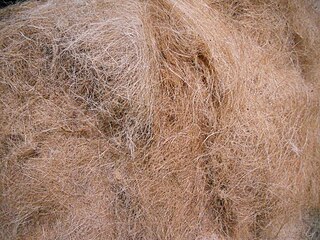
Coir, also called coconut fibre, is a natural fibre extracted from the outer husk of coconut, and used in products such as floor mats, doormats, brushes, and mattresses. Coir is the fibrous material found between the hard, internal shell and the outer coat of a coconut. Other uses of brown coir are in upholstery padding, sacking and horticulture. White coir, harvested from unripe coconuts, is used for making finer brushes, string, rope and fishing nets. It has the advantage of not sinking, so can be used in long lengths in deep water without the added weight dragging down boats and buoys.

Topsoil is the upper layer of soil. It has the highest concentration of organic matter and microorganisms and is where most of the Earth's biological soil activity occurs.

Floriculture is the study of the efficient production of the plants that produce showy, colorful flowers and foliage for human enjoyment and the human environment. It is a commercially successful branch of horticulture and agriculture found throughout the world. Efficient production practices have been developed over the years, for the hundreds of plant taxa used in the floral industry, increasing the overall knowledge of whole plant biology. Plant breeding and selection have produced tens of thousands of new genotypes for human use. Jasmine, Marigold,Chrysanthemum, Rose, Orchid, Anthurium etc. are flowers of commercial demand.

Loam is soil composed mostly of sand, silt, and a smaller amount of clay. By weight, its mineral composition is about 40–40–20% concentration of sand–silt–clay, respectively. These proportions can vary to a degree, however, and result in different types of loam soils: sandy loam, silty loam, clay loam, sandy clay loam, silty clay loam, and loam.

A growbag is a planter filled with a growing medium and used for growing plants, usually tomatoes or other salad crops. Originally made of plastic, modern bags are also made from jute or fabric. The growing medium is usually based on a soilless organic material such as peat, coir, composted green waste, composted bark or composted wood chips, or a mixture of these. Various nutrients are added, sufficient for one season's growing, so frequently only planting and watering are required of the end-user. Planting is undertaken by first laying the bag flat on the floor or bench of the growing area, then cutting access holes in the uppermost surface, into which the plants are inserted.
Biointensive agriculture is an organic agricultural system that focuses on achieving maximum yields from a minimum area of land, while simultaneously increasing biodiversity and sustaining the soil fertility. The goal of the method is long term sustainability on a closed system basis. It is particularly effective for backyard gardeners and smallholder farmers in developing countries, and also has been used successfully on small-scale commercial farms.
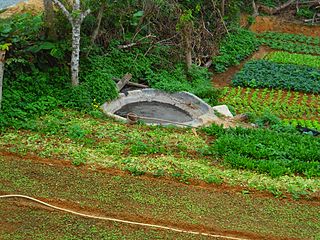
Organic fertilizers are fertilizers that are naturally produced. Fertilizers are materials that can be added to soil or plants, in order to provide nutrients and sustain growth. Typical organic fertilizers include all animal waste including meat processing waste, manure, slurry, and guano; plus plant based fertilizers such as compost; and biosolids. Inorganic "organic fertilizers" include minerals and ash. The organic-mess refers to the Principles of Organic Agriculture, which determines whether a fertilizer can be used for commercial organic agriculture, not whether the fertilizer consists of organic compounds.
This is an alphabetical index of articles related to gardening.
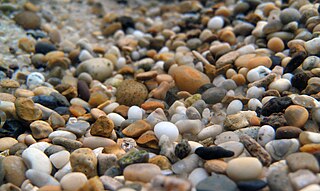
The substrate of an aquarium refers to the material used on the tank bottom. It can affect water chemistry, filtration, and the well-being of the aquarium's inhabitants, and is also an important part of the aquarium's aesthetic appeal. The appropriate substrate depends on the type of aquarium; the most important parameter is whether the aquarium contains fresh water or saltwater.

Pinguicula primuliflora, commonly known as the southern butterwort or primrose butterwort, is a species of carnivorous plant belonging to the genus Pinguicula. It is native to the southeastern United States. The typical variety forms a white flower in blooming. Like other butterworts, it has sticky adhesive leaves which attract, capture and digest arthropod prey in order to supply the plant with nutrients such as nitrogen not found in the nutrient poor, acidic soil that it grows in. Its name derives from the fact it is usually the first one to flower in the spring.
Sand-based athletic fields are sports turf playing fields constructed on top of sand surfaces. It is important that turf managers select the most suitable type of sand when constructing these fields, as sands with different shapes offer varied pros and cons. Regular maintenance of sand-based athletic fields is just as important as the initial construction of the field. As water and other aqueous solutions are added, a layer of thatch may accumulate on the surface of the turf. There are different ways to manage this level of thatch, however the most common are aeration and vertical mowing.
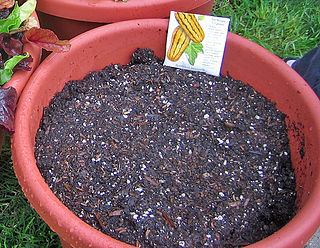
Potting soil or growing media, also known as potting mix or potting compost (UK), is a substrate used to grow plants in containers. The first recorded use of the term is from an 1861 issue of the American Agriculturist. Despite its name, little or no soil is usually used in potting soil.
The Centre for Appropriate Rural Technology (CART) is a community-driven sustainable development project located in the Eastern Cape of South Africa. It functions as a life skills centre in the heart of Sicambeni Village, a rural village near Port St Johns.
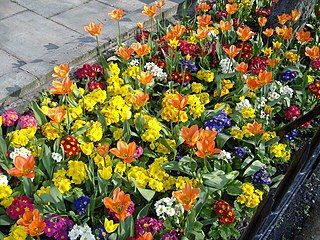
Many types of flowering plants are available to plant in flower gardens or flower beds. The floral industry calls these plants, bedding plants. These fast-growing plants in seasonal flower beds create colourful displays, during spring, summer, fall or winter, depending on the climate. Plants used for bedding are generally annuals, but biennials, tender perennials, and succulents are used.
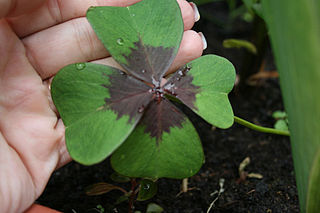
Oxalis tetraphylla is a bulbous herbaceous perennial plant from Mexico. It is sometimes sold as lucky clover or shamrock. In the wild or feral state it is often called four-leaved wood-sorrel after its family, Oxalidaceae. Other English common names for this plant include Lucky Clover, Four-Leaf Sorrel, Four-Leaf Pink-Sorrel and others. It is sometimes called "the iron cross plant" or "oxalis iron cross" because the leaves loosely resemble the iron cross symbol, though this name is not a classic folk term and has fallen out of favour due to the bad political connotations associated with this symbol.
References
- 1 2 3 4 5 Fisher, Sue. "What is John Innes compost?". Gardener's World. Retrieved 17 May 2023.
- 1 2 "The John Innes Centre and the compost that bears our name". John Innes Centre. Retrieved 5 May 2022.
- ↑ "John Innes: more than just a compost". johninnessvc.wordpress.com. 9 September 2013. Retrieved 25 September 2019.
- 1 2 3 4 "John Innes potting compost". RHS. Retrieved 17 May 2023.
- 1 2 3 4 5 6 7 "How to make your own John Innes compost". Proctors. Retrieved 17 May 2023.
- ↑ "JIMA Compost". Horticultural Trades Association. Retrieved 7 November 2023.
- ↑ "How to make John Innes compost". The Garden of Eaden. Retrieved 17 May 2023.